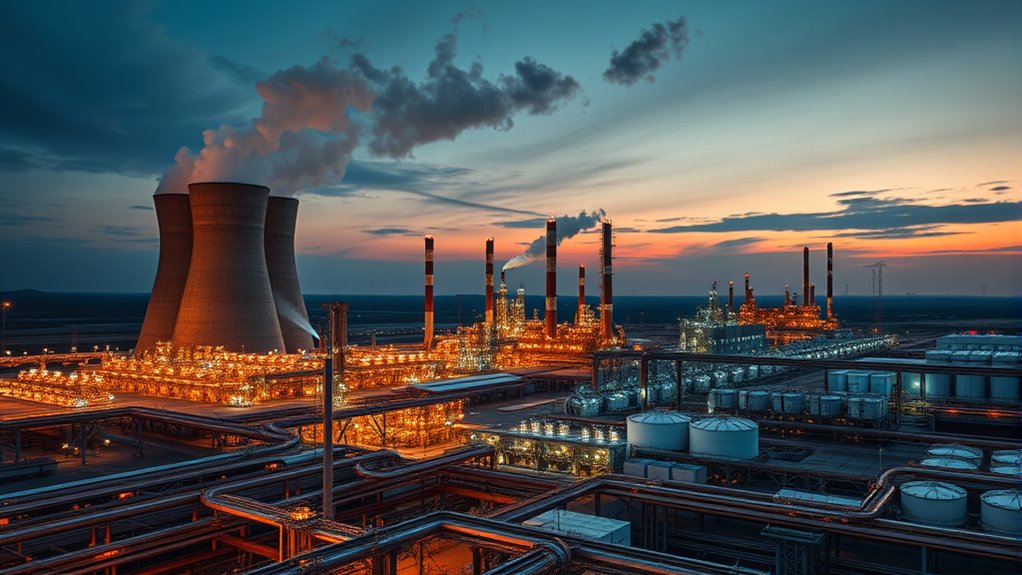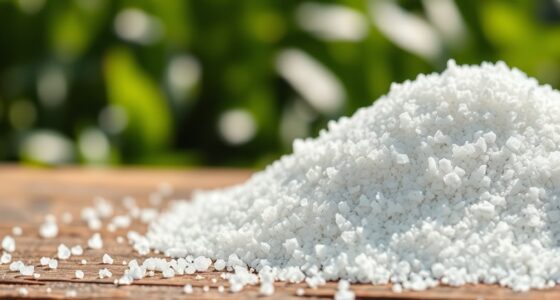Sulfuric acid is mainly produced via the Contact Process, where sulfur is burned to make sulfur dioxide, which then converts into sulfur trioxide before forming the acid. This process is crucial for industries like fertilizer and petroleum refining but also has environmental impacts, such as pollution. The global supply chain relies on major producers like China and the U.S., and factors like geopolitics can affect availability and prices. Continue exploring to discover how innovations are shaping a more sustainable future.
Key Takeaways
- Sulfuric acid is primarily produced via the Contact Process, involving sulfur combustion and oxidation of sulfur dioxide to sulfur trioxide.
- Major global producers include China, the US, and Europe, with extensive infrastructure supporting large-scale manufacturing.
- The production process emits pollutants like SO₂ and SO₃, prompting industry innovations for cleaner and more efficient methods.
- Supply chains are influenced by geopolitical, environmental, and economic factors affecting availability and pricing worldwide.
- Efforts are ongoing to improve sustainability through process improvements, alternative raw materials, and emission reduction technologies.

Have you ever wondered what makes sulfuric acid one of the most widely used chemicals in the world? It’s because of its versatility and indispensable role across various industries. But as you explore its significance, it’s important to recognize the environmental impact associated with its production and use. Sulfuric acid is primarily made through the Contact Process, which involves burning sulfur to produce sulfur dioxide, then oxidizing it to sulfur trioxide, and finally converting it into the acid. This process, while efficient, releases pollutants like sulfur dioxide and sulfur trioxide into the atmosphere, contributing to environmental issues such as acid rain and air pollution. If you’re concerned about sustainability, understanding these impacts helps you realize why regulations and cleaner production methods are becoming increasingly important. Additionally, the growing demand for industrial chemicals continues to influence production practices and environmental considerations.
From an industrial perspective, sulfuric acid’s applications are vast. You rely on it in the manufacturing of fertilizers, especially phosphates, which are critical to global agriculture. It’s also used in petroleum refining, to remove impurities and improve fuel quality. In the production of chemicals, dyes, and synthetic fibers, sulfuric acid serves as a catalyst or raw material, enabling the creation of countless everyday products. Its role in wastewater treatment and metal processing highlights its importance in maintaining safety and efficiency across sectors. When you consider the supply chain, sulfuric acid’s global reach becomes evident. Major producing regions include China, the United States, and countries in Europe, where extensive industrial infrastructure supports large-scale manufacturing. These regions export sulfuric acid to meet worldwide demand, creating complex supply chains that can be sensitive to geopolitical and environmental factors.
As you think about the broader picture, it’s clear that the environmental impact of sulfuric acid production is a concern that industry leaders continually address through technological innovations. Improvements like better scrubbers and alternative raw materials aim to reduce emissions and mitigate ecological harm. Simultaneously, the global demand for sulfuric acid ensures that industries keep refining their processes to balance economic benefits with environmental responsibility. Understanding these dynamics can help you appreciate the importance of sustainable practices in maintaining the availability of this crucial chemical while protecting the planet. Whether you’re involved in policy-making, manufacturing, or simply concerned about environmental health, recognizing the intricate relationship between sulfuric acid’s industrial applications and its environmental footprint is key to supporting responsible development.
Frequently Asked Questions
What Are the Environmental Impacts of Sulfuric Acid Production?
You should know that sulfuric acid production can cause significant environmental impacts, including emissions of sulfur dioxide and other pollutants that contribute to acid rain and air quality issues. Waste management is also vital, as improper handling of by-products can lead to soil and water contamination. By monitoring emissions and implementing proper waste management practices, you can minimize these environmental effects and promote more sustainable production.
How Is Sulfuric Acid Transported Safely Across Borders?
You might think shipping sulfuric acid is risky, but strict shipping regulations and container safety measures make it secure. You guarantee proper labeling, use corrosion-resistant containers, and follow international protocols like IMDG Code to prevent leaks and accidents. These practices confirm that, with careful handling and adherence to regulations, sulfuric acid can be transported safely across borders, protecting both people and the environment.
What Are Emerging Technologies in Sulfuric Acid Manufacturing?
You should watch for emerging technologies like innovative catalysts, which enhance efficiency and reduce energy consumption in sulfuric acid manufacturing. Green synthesis methods are gaining traction, minimizing environmental impact by using sustainable raw materials and processes. These advancements help you produce sulfuric acid more sustainably, lowering emissions and waste. Staying updated on these technologies allows you to improve your production practices and align with industry trends toward greener, more efficient chemistry.
How Does Sulfuric Acid Pricing Fluctuate Globally?
You’ll find sulfuric acid prices fluctuate like a rollercoaster, driven by market demand and geopolitical influences. When demand surges, prices tend to spike; during political tensions or trade disputes, they can plunge or become unpredictable. Global events, supply chain disruptions, and regional policies all play a part. Staying informed about these factors helps you anticipate price shifts and make smarter decisions in this dynamic market.
What Are the Main Safety Protocols for Handling Sulfuric Acid?
When handling sulfuric acid, you need to wear protective gear like gloves, goggles, and acid-resistant clothing to prevent burns. Always make certain spill containment measures are in place, such as drip trays and neutralizing agents nearby. Follow proper procedures for transferring and storing the acid, and work in well-ventilated areas. If a spill occurs, act quickly to contain it and clean it up safely to minimize hazards.
Conclusion
Remember, the road to success is always under construction. As you’ve seen, sulfuric acid is crucial to countless industries, shaping our daily lives. Its production and global supply chain are complex but necessary. By understanding these processes, you appreciate the interconnectedness of modern technology and resources. Keep in mind, “A chain is only as strong as its weakest link,” so supporting sustainable and efficient practices ensures a brighter, more reliable future for everyone.








